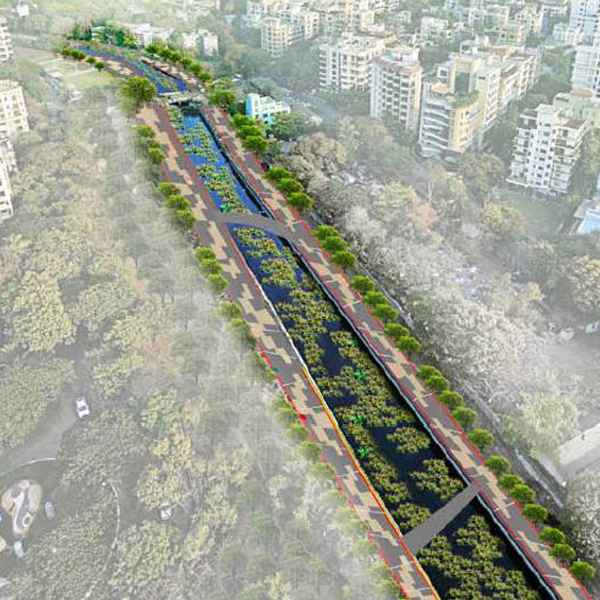The archipelago of Mumbai City is 47 km long, with an average width of 10 km. The city's population is over 14 million, and people have little access to open space. Imagine this: Mumbaikars with access to over 600 km of landscaped walking and cycling tracks, and open spaces along watercourses that interweave through various part of the city's urban fabric? This is the vision of our collective effort: the Irla Nullah Re-invigoration Project. It is a vision that would transform Mumbai's landscape. Furthermore, we aspire to transform how Mumbai's institutions approach open space and provide equitable access to ecosystem services for millions.
Mumbai is a city on the water, with a vast expanse of natural assets. Sadly, the city has turned its back on them and considered them dumping grounds, both physically and metaphorically. This has led to their degradation risks such as flooding and pollution. Our objective is to restore these natural assets and integrate them across the city.
Our plan, which is a part of a larger citizens' movement advocating the 'Vision Juhu' Plan, focuses on cleaning a polluted natural watercourse in the coastal suburb of Juhu, into a vibrant public space.
Our movement is executed through the participation of local citizens, elected representatives, officials of the government, celebrities, educational and commercial institutions, the Municipal Corporation of Greater Mumbai (MCGM) and certain state and national government agencies. An extensive public communications campaign has led to wider participation in the project.
Importantly, this project exemplifies the need to involve diverse stakeholders in the people's "Right to the City", and their role in scripting urban growth. This requires systemic change in city institutions, and how people participate in the democratic process. The challenges are significant, and include the conservation of vital natural assets; their integration with the urban landscape; expanding public spaces (both physical and democratic); expanding tree cover; demystifying the planning process; and promoting the idea of neighborhood-based city planning. The project will model a paradigm shift in understanding Mumbai's ecology and use nature-based solutions to improve the quality of life for many more Mumbaikars.
This initiative addresses the abuse and exclusion of over 300 km of watercourses, including four rivers that have been turned into nullahs, or drains. It brings to light the continuing degradation of 140 sq. km of natural areas in the city, including mangroves, wetlands, creeks, salt pans, rivers, lakes, beaches, hills and forests, and the need to restore the symbiotic relationships among them. City authorities have been apathetic towards the protection of both natural and open spaces, and have neglected their integration with the city's Development Plan.
Our project, originally conceived by P.K. Das, is now supported in part by public funding and executed by a public agency (Maharashtra Housing & Area Development Authority). Responsibility for planning and monitoring lies with the Gulmohar Area Societies Welfare Group -- the local citizens' association, and architects P.K. Das & Associates (PKDA).
PKDA, along with the Participatory Urban Design & Development Initiative (PUDDI- a charitable trust) have initiated a study of a plan to formalize an institutional participatory framework and budget allocation to undertake the re-invigoration plan across Mumbai's watercourses.
Client: Residents of Juhu
Irla Nullah length: 7.5km
Project Period: 2013 - ongoing
Related Links:
